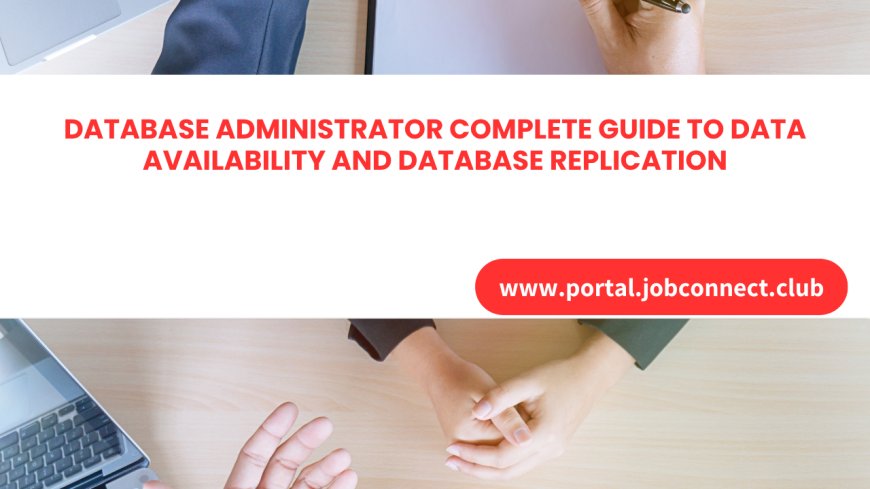Database Administrator Complete Guide to Data Availability and Database Replication
Learn the fundamentals of data availability, replication, clustering, and load balancing in databases. A perfect guide for IT and DevOps interview preparation.

Understanding Data Availability and Database Reliability
Ensuring that data is always accessible, secure, and consistent is essential for any modern business. This guide covers key concepts and practices around data availability, database replication, load balancing, and clustering—core topics frequently asked in data engineering, system admin, and DevOps interviews.
1. What is Data Availability?
Data availability refers to the ability of systems, applications, and users to access data reliably whenever needed. It involves a combination of infrastructure, processes, and policies designed to ensure that data remains reachable and usable—even during failures or peak usage periods.
2. What is Data Compliance?
Data compliance ensures that organizations follow legal and regulatory standards related to data availability and handling.
-
Involves maintaining audit trails
-
Utilizes compliance frameworks (like GDPR, HIPAA, etc.)
-
Demonstrates proper control and monitoring over data systems
3. Key Methods to Ensure Data Availability
-
Backup and Restore: Regularly backing up data and testing restore processes.
-
Replication: Keeping multiple copies of data across nodes or data centers.
-
Clustering & Load Balancing: Ensures continued operation even if one server fails.
-
Monitoring & Alerting:
-
Track uptime, throughput, latency
-
Set up alerts for downtime or performance issues
-
-
Security and Compliance Controls:
-
Encryption, access controls, and logging
-
-
Automated Failover & Failback:
-
Automatically switches to a backup server upon failure
-
Heartbeat monitoring ensures quick failover and safe return to primary when recovered
-
4. Challenges to Data Availability
-
Hardware/server failure
-
Data inconsistencies (incomplete or duplicated)
-
Use of legacy or outdated systems
-
Storage hardware failures
-
Network outages and slow data transfers
-
Cybersecurity threats and data breaches
-
Compatibility issues between systems
5. Database Heartbeat and Pulse Monitoring
These are tools and techniques used in high-availability systems:
-
Heartbeat:
-
Periodic signals sent between nodes to indicate system health
-
Helps detect node or network failures quickly
-
-
Pulse Checks:
-
Monitor overall system diagnostics like query lag, replication status, CPU/memory usage
-
-
Popular Tools:
-
Prometheus, Nagios, Patroni, Kubernetes
-
6. What is Database Replication?
Replication means duplicating database contents to ensure consistency and fault tolerance.
Types of Replication:
-
Physical Replication: Bit-by-bit copying of the entire database
-
Logical Replication: Copies selected tables, rows, or changes based on SQL
Replication Timing:
-
Synchronous: Real-time updates to replicas
-
Asynchronous: Updates occur with a time lag
-
Modes: Real-time vs Scheduled batch replication
7. Advantages of Database Replication
-
High availability and disaster recovery
-
Faster query response and low latency
-
Better load distribution
-
Improved support for business intelligence and analytics
-
Minimizes downtime and data loss
8. Risks and Challenges of Replication
-
Data inconsistencies due to replication lag
-
Higher storage and resource usage
-
Increased infrastructure and compliance complexity
-
Security vulnerabilities in transmission
-
Delayed failovers or backups during high load
9. What is Replication Lag?
Replication lag occurs when changes made to the primary database are not reflected immediately on replicas.
Risks:
-
Inaccurate or outdated data
-
Application errors or failed reports
-
Missed alerts in critical systems
-
Backup inconsistencies
Causes:
-
Network congestion
-
High write load on the primary
-
Poor performance of replica systems
-
Hardware bottlenecks
Solutions:
-
Optimize network and disk I/O
-
Use high-performance hardware
-
Tune SQL and hardware configs
-
Choose logical replication for more flexibility
10. What is a Load Balancer in Databases?
A load balancer distributes traffic or database queries across multiple servers to improve system performance and reliability.
Benefits:
-
Prevents any one server from being overwhelmed
-
Enables horizontal scaling
-
Provides failover capability
Load Balancing Algorithms:
-
Round Robin
-
Least Connections
-
IP Hash
-
Weighted Distribution
Types:
-
Hardware-Based: Cisco, F5
-
Software-Based: Nginx, HAProxy
-
Cloud-Based: AWS ELB, Azure Load Balancer
11. What is Database Clustering?
Clustering is the use of multiple database servers acting as one system to ensure high availability and scalability.
Types of Clusters:
-
Shared-Nothing: Independent nodes with separate storage
-
Shared-Disk: Nodes share a common storage system
-
Shared-Everything: Full sharing of memory and data
-
Load-Balanced: Uses balancers to distribute workload
-
Federated: Virtual combination of independent databases
Advantages:
-
Continuous availability
-
Load distribution and improved performance
-
Scalable infrastructure
-
Effective disaster recovery
Challenges:
-
Complex setup and configuration
-
Increased costs for hardware and software
-
Synchronization and data consistency management